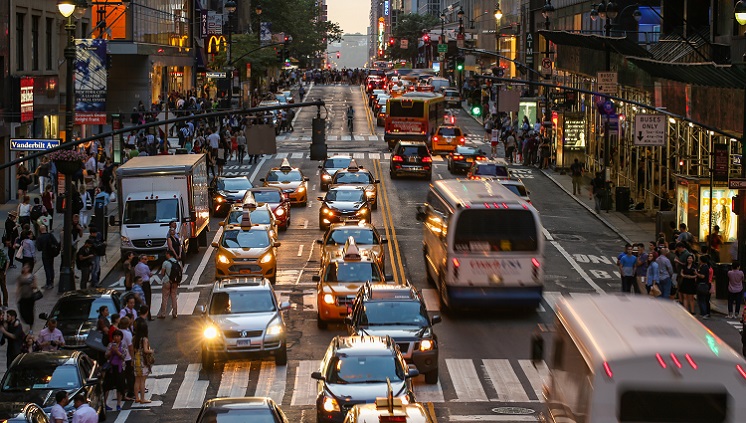Are excessively loud vehicles keeping you up at night? B.C. councillors have a solution

Photo via iStock.
At their annual convention from Sept. 16-20, the Union of B.C. Municipalities (UBCM) endorsed a resolution asking the provincial government to introduce a noise camera pilot project, which is intended to reduce noise pollution from excessively loud vehicles.
National Geographic defines noise pollution as “any unwanted or disturbing sound that affects the health and well-being of humans and other organisms.” Studies have shown that excessive noise is linked to a number of adverse health outcomes, from hearing loss and tinnitus to cardiovascular disease, sleep disturbance, and increased stress.
Noise pollution can come from a variety of sources, such as industrial work, construction, air traffic, as well as regular road traffic.
Noise cameras are one measure which can be used to combat vehicular noise pollution. They are cameras “equipped with high-definition audio and visual sensors, [and] can continuously monitor noise levels and capture violations of local noise regulations in real-time,” according to a press release from Saanich Councillor Teale Phelps Bondaroff.
Port Moody Councillor Samantha Agtarap told the Martlet that, for cities to deploy traffic or noise cameras, they require approval from the province.
“The question was really asking the province to give us the opportunity to opt into a pilot, so we can test noise cameras, because it’s relatively a kind of newer technology,” said Agtarap, “and to give municipalities a method to manage noise, because currently it’s really hard to do that unless the police are sitting there.”
A report provided by Phelps Bondaroff notes that noise cameras have been implemented in other cities in Canada and beyond, including Calgary, Edmonton, New York City, and Paris, as well as several cities in the United Kingdom.
In B.C., vehicle noise is currently regulated by the Motor Vehicle Act, which sets strict limits for how loud engine and exhaust noise can be. The limit varies according to class of vehicle — from “light duty” vehicles at 88 A-weighted decibels (dBA) to “diesel-driven heavy duty” vehicles, for which the limit is 93 dBA.
Decibels are measured on a logarithmic scale, which means an increase of three decibels equals a doubling of sound intensity, and an increase of ten decibels equals an increase in sound intensity by a factor of ten.
While excess noise is regulated under the act, enforcement is another matter. Even when vehicular noise pollution causes significant disturbances — for example, a car with a modified or after-market muffler producing excessive noise — it can be difficult for the authorities to do anything about it.
“If someone wakes you up in the middle of the night, by the time you put on your robe, you get to the window, that car’s long gone,” said Phelps Bondaroff. “You can’t get the actual information to call [the] police or bylaw, and as a result, that just continues to persist.”
Phelps Bondaroff told the Martlet that noise cameras work similar to speed cameras, which are activated when a vehicle enters its range at excessive speeds. Noise cameras use a microphone, which picks up vehicle noise in excess of the legal limit.
“That would give enough actionable information to law enforcement to pursue that person with a ticket, and/or other actions,” he said.
Phelps Bondaroff said that, while Saanich police receive less complaints about excessive vehicle noise than might be expected, he’s heard far more community members express their concerns.
“What’s clear to me is that this is an issue in the community. People aren’t wasting police time with non-actionable information,” he said. “There’s a problem that needs to be addressed, and we have the technology to solve that problem.”
Agtarap, who advocated for the resolution at UBCM, said that there is a significant equity dimension to noise pollution. Generally speaking, she said, lower income and less expensive housing tends to be built in busier areas, which are often noisier.
While people from many different backgrounds live in these areas, quite often it’s students, who cannot always afford to live in quiet areas.
Isabella Loberiza, a fifth year biology student at Vancouver Island University, told the Martlet she lives in a “rougher” area of Nanaimo. She said, in addition to regularly hearing sirens from emergency vehicles, she hears excessive vehicular noise at least three or four times a week, often very late at night.
“I could hear at any point during the day,” said Loberiza, “but usually it’s about from 11:00 p.m. to three in the morning.”
Loberiza said vehicular noise pollution does not prevent her from studying, but it does affect her ability to sleep, which can in turn impact her studies.
“If I have a midterm the next day or something, it’s kind of hard to fall asleep and hard to stay asleep,” she said. “With the stresses of school already, I think that it’s tough coming home, and then trying to get to sleep, and then not even getting peace from that.”








